- About
-
Research
- Agronomy and farming systems
-
Agricultural crop research
-
Research projects - agriculture
- About SASSA-SAI
- BioBoost
- Biomass Connect
- CTP for Sustainable Agricultural Innovation
- Climate Ready Beans - workshop presentations (March 2022)
- Crop diversity HPC cluster
- Designing Future Wheat
- Final project workshop
- Get involved
- List of materials
- News and updates
- Partners
- Rustwatch
- The Sentinel Crop Disease Surveillance Network
- The research team
- UK Cereal Pathogen Virulence Survey
- UK wheat varieties pedigree
- Weed management - IWM Praise
- Crop breeding
- Crop characterisation
- Data sciences
- Genetics and pre-breeding
- Plant biotechnology
- Plant pathology and entomology
- Resources
-
Research projects - agriculture
-
Horticultural crop research
-
Research projects - horticulture
- Augmented Berry Vision
- BEESPOKE
- Boosting brassica nutrition in smart growing systems
- CTP for Fruit Crop Research
- Develop user-friendly nutrient demand models
- Egg laying deterrents for spotted wing drosophila
- Enhancing the nutritional quality of tomatoes
- Improving berry harvest forecasts and productivity
- Improving vineyard soil health through groundcover management
- Intelligent growing systems
- Knowledge transfer for sustainable water use
- POME: Precision Orchard Management for Environment
- RASCAL
- STOP-SPOT
- UV-Robot
- Crop science and production systems
- Genetics, genomics and breeding
- Pest and pathogen ecology
- Field vegetables and salad crops
- Plum Demonstration Centre
- The WET Centre
- Viticulture and Oenology
-
Research projects - horticulture
- Crop Science Centre
-
Services
- Analytical Services
- Business Development
- Commercial trial services
- Membership
- Plant breeding
- Plant characterisation
- Seed certification
-
Training
-
Technical agronomy training
- Advanced crop management of bulb onions
- Advanced crop management of vegetable brassicas
- Advanced nutrient management for combinable crops
- Benefits of cover crops in arable systems
- Best practice agronomy for cereals and oilseed rape
- Developing a Successful Strategy for Spring Crops
- Disease Management and Control in Cereal Crops
- Incorporating SFI options into your rotation
- Protected Environment Horticulture – Best Practice
- Techniques for better pest management in combinable crops
- Crop inspector and seed certification
- Licensed seed sampling
-
Technical agronomy training
- News & Views
- Events
-
Knowledge Hub
- Alternative and break crops
-
Crop genetics
- POSTER: Diversity enriched wheat (2025)
- POSTER: Genetics of wheat flag leaf size (2024)
- POSTER: Wheat yield stability (2024)
- Poster: Traits for future cereal crops (2022)
- POSTER: wild wheat fragment lines (2022)
- POSTER: Improving phenotyping in crop research (2022)
- PRESENTATION: Plant breeding for regen ag
- Poster: Designing Future Wheat (2020)
- Crop nutrition
-
Crop protection
- POSTER: Understanding the hierarchy of black-grass control (2025)
- POSTER: Emerging weed threats (2025)
- POSTER: Disease control in barley (2025)
- Poster: Weed seed predation in regen-ag (2024)
- POSTER: Disease control in winter wheat (2025)
- POSTER: Mode of action (2023)
- POSTER: Inter-row cultivation for black-grass control (2022)
- POSTER: UKCPVS winter wheat yellow rust in spring 2025 (2025)
- Poster: Management of Italian ryegrass (2021)
- POSTER: UKCPVS winter wheat rusts - 2024/25 review (2025)
- POSTER: UKCPVS disease monitoring and the benefit to UK growers (2025)
- POSTER: Diagnosing and scoring crop disease using AI (2025)
- POSTER: Finding new sources of Septoria resistance (2024)
- POSTER: Fungicide resistance research (2024)
- POSTER: Detecting air-borne pathogens (2024)
- POSTER: Oilseed rape diseases (2024)
- POSTER: Fungicide resistance research (2024)
- POSTER: Improving chocolate spot resistance (2022)
- Poster: Pathogen diagnostics (2022)
- Fruit
- Regen-ag & sustainability
-
Seed certification
- POSTER: Wheat DUS (2024)
- POSTER: Innovation in variety testing (2024)
- POSTER: AI and molecular markers for soft fruit (2024)
- POSTER: Barley crop identification (2023)
- POSTER: Herbage grass crop identification (2023)
- POSTER: Herbage legume crop identification (2024)
- POSTER: Minor cereal crop inspecting (2023)
- POSTER: Pulse crop identification (2023)
- POSTER: Wheat crop identification (2023)
-
Soils and farming systems
- POSTER: Checking soil health - across space and time (2024)
- POSTER: Checking soil health - step by step (2024)
- POSTERS: Changing soil management practices (2022)
- Poster: Monitoring natural enemies & pollinators (2021)
- POSTER: Soil structure and organic matter (2024)
- POSTER: Novel wheat genotypes for regen-ag (2024)
- Video: New Farming Systems project (2021)
- Video: Saxmundham Experimental Site (2021)
- POSTER: Impact of prolonged rainfall on soil structure (2024)
- POSTER: Soil & agronomic monitoring study (2024)
- POSTER: The impact of rotations & cultivations (2024)
- VIDEO: Great Soils; soil sampling guidelines (2020)
- Poster: Soil invertebrates within arable rotations (2024)
- VIDEO: Soil health assessment (2021)
- POSTER: Saxmundham - modern P management learnings
- POSTER: Saxmundham - 125 years of phosphorus management
- Poster: Soil phosphorus - availability, uptake and management (2025)
- POSTER: Morley long term experiments (2025)
- POSTER: Exploiting novel wheat genotypes for regen-ag (2025)
- Video: Saxmundham Experimental Site (2021)
- Varieties
Key findings from The WET Centre

Here are some of the key findings to have come out of the WET Centre during its operation:
Precision irrigation and water use efficiency
Early work demonstrated that water savings could be achieved by using precision irrigation (PI) tools, a sensor-based, fully automated system that consistently supplies sufficient water to achieve a target run-off volume from coir bags or containers, and ensures that plant demand is met with supply at different developmental stages and in variable weather.
With commercial strawberry growers typically irrigating substrate-grown crops to 15-20% run-off, the Centre has demonstrated how growers can reduce their total water use each season by up to 33%. This has been achieved by employing PI that relies on some of the most advanced technology, allowing us to reduce the level of run-off to less than 5% of input volume without any significant difference in Class 1 yields or any compromise in fruit quality.
Measuring run-off from bags at the WET Centre
Research carried out at East Malling between 2011 and 2013 showed that the UK industry average use of water for an everbearer strawberry crop amounted to 82 m3 per tonne of Class 1 fruit produced. Typically, at the WET Centre, a figure of 43 m3 has been achieved through PI and at best it has been lowered to 34 m3. A more recent grower survey in 2023 showed that the most efficient grower had used 60 m3 for an everbearer crop, demonstrating industry improvement after the Centre was set up.
Water self-sufficiency
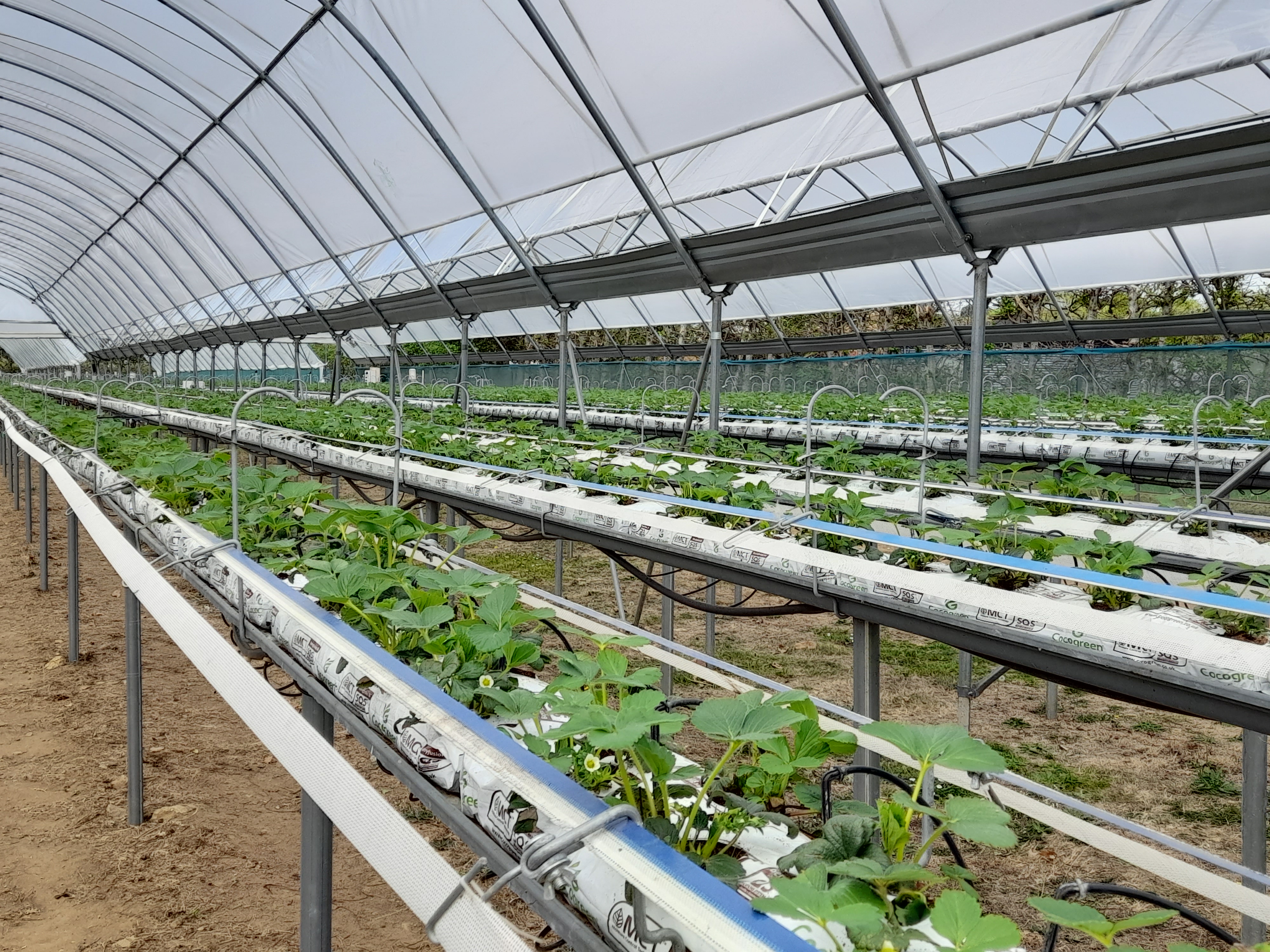 Rainwater harvesting has achieved 90% self-sufficiency in water
Rainwater harvesting has achieved 90% self-sufficiency in water
Precision irrigation has also been combined with rainwater harvesting and re-use, to enable the Centre to achieve 90% self-sufficiency in water, even in very dry summers such as 2018. This not only improves local water security but also reduces the volume of acid needed to acidify rainwater compared to mains water. Its use also reduces water flow from polytunnels, improves humidity control within the tunnels and lowers the risk of soil erosion and compaction.
Yields and light interception
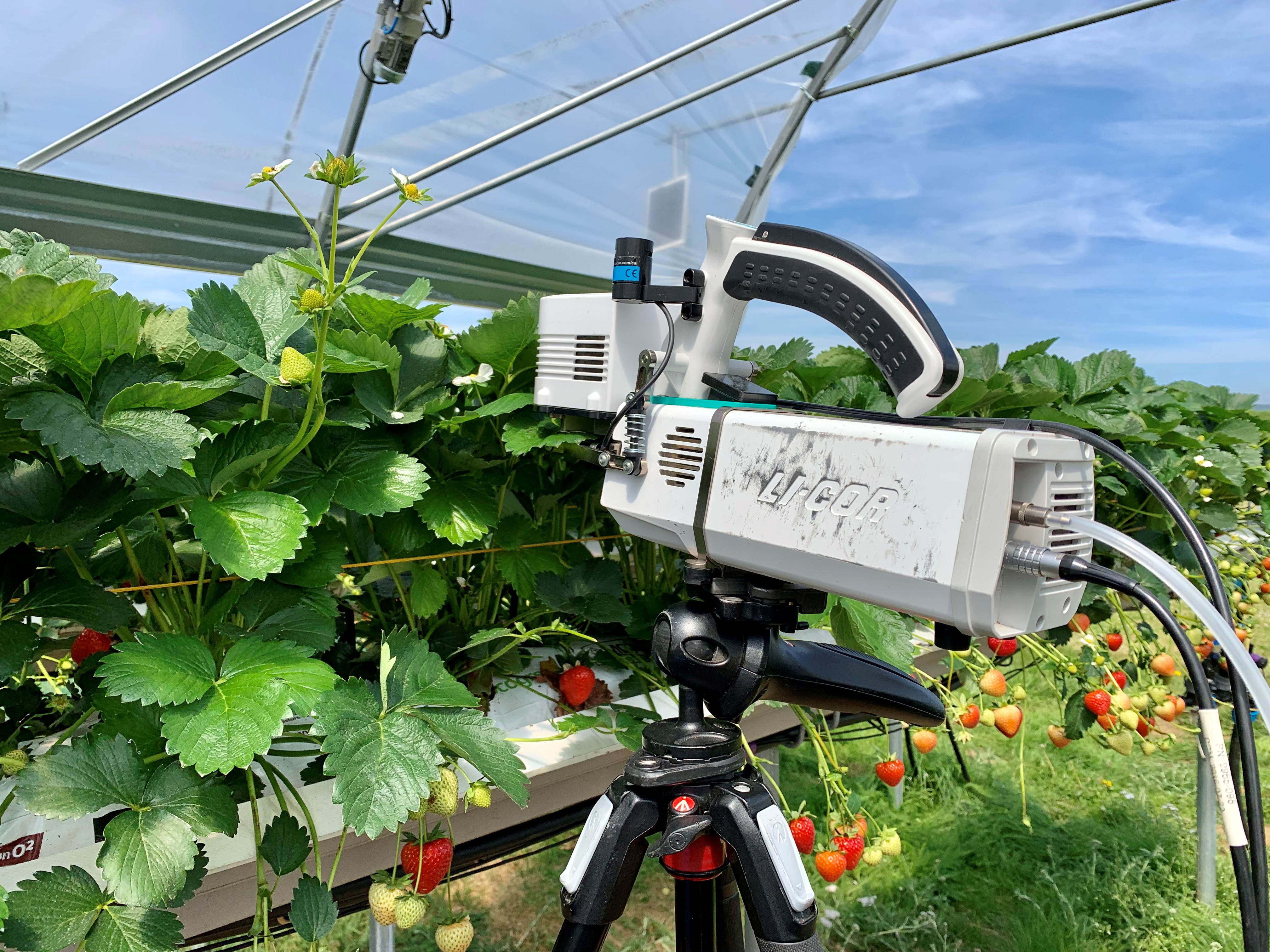 Measuring photsynthetic activity
Measuring photsynthetic activity
Having highlighted methods of using water more efficiently, attention turned to maximising yield potential from everbearer strawberry plants. Comparisons between the commercial and advanced areas demonstrated significant differences in marketable yield using the everbearer Malling Champion. In 2020, Class 1 yield was found to be 5% higher in the commercial area, perhaps a result of the higher levels of shading in the advanced area, lowering the photosynthetically active radiation (PAR) at the canopy height by 3–7%.
It is thought that the increased steelwork associated with the roof vents in the advanced tunnels reduces light levels sufficiently to cause this yield difference, and this effect is probably exacerbated by the relatively large rainwater collection gutters. However, the more flexible venting control resulted in a 1°C reduction in temperature in June and July and up to 7°C in August 2020, and so the improved internal climate control from auto-venting could have significant benefits in terms of cropping potential in hotter years. In addition, since manual venting of tunnels is time-consuming and therefore expensive, auto-venting could also help to lower labour costs.
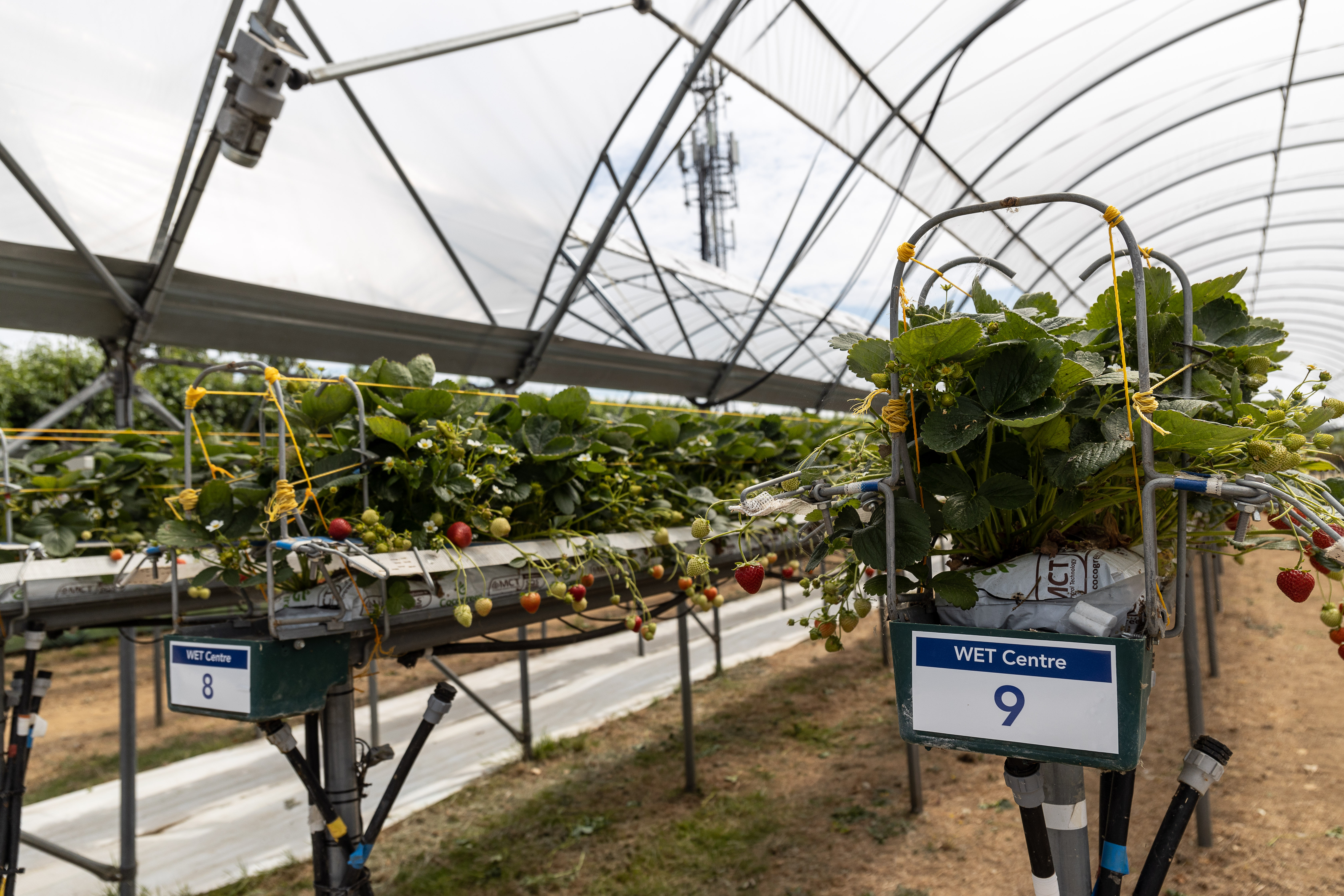 Increased steelwork in the advanced area is thought to have reduced light availability
Increased steelwork in the advanced area is thought to have reduced light availability
Seasonal yield differences and crop row position
In each growing season, a strong correlation between light availability (PAR) and Class 1 yields was recorded in everbearer varieties. This was particularly noticeable when comparing seasons 2020 and 2021 - exceptionally high PAR throughout the 2020 season led to 50% higher yields in Malling Champion compared to 2021 when the accumulated PAR over the growing season was much lower. Differences in PAR were also recorded within tunnels, leading to Class 1 yields differing by as much as 12% in rows just 2 metres apart within one tunnel bay - this equates to a yield differential of over 11 tonnes per hectare.
As a result of higher levels of PAR being recorded in the middle rows of a six-row tunnel bay, Rows 3 and 4 produced the highest Class 1 yields and the outside rows (1 and 6) the lowest. The efficiency of photosynthesis was highest in Row 4 and also higher in the morning than in the afternoon.
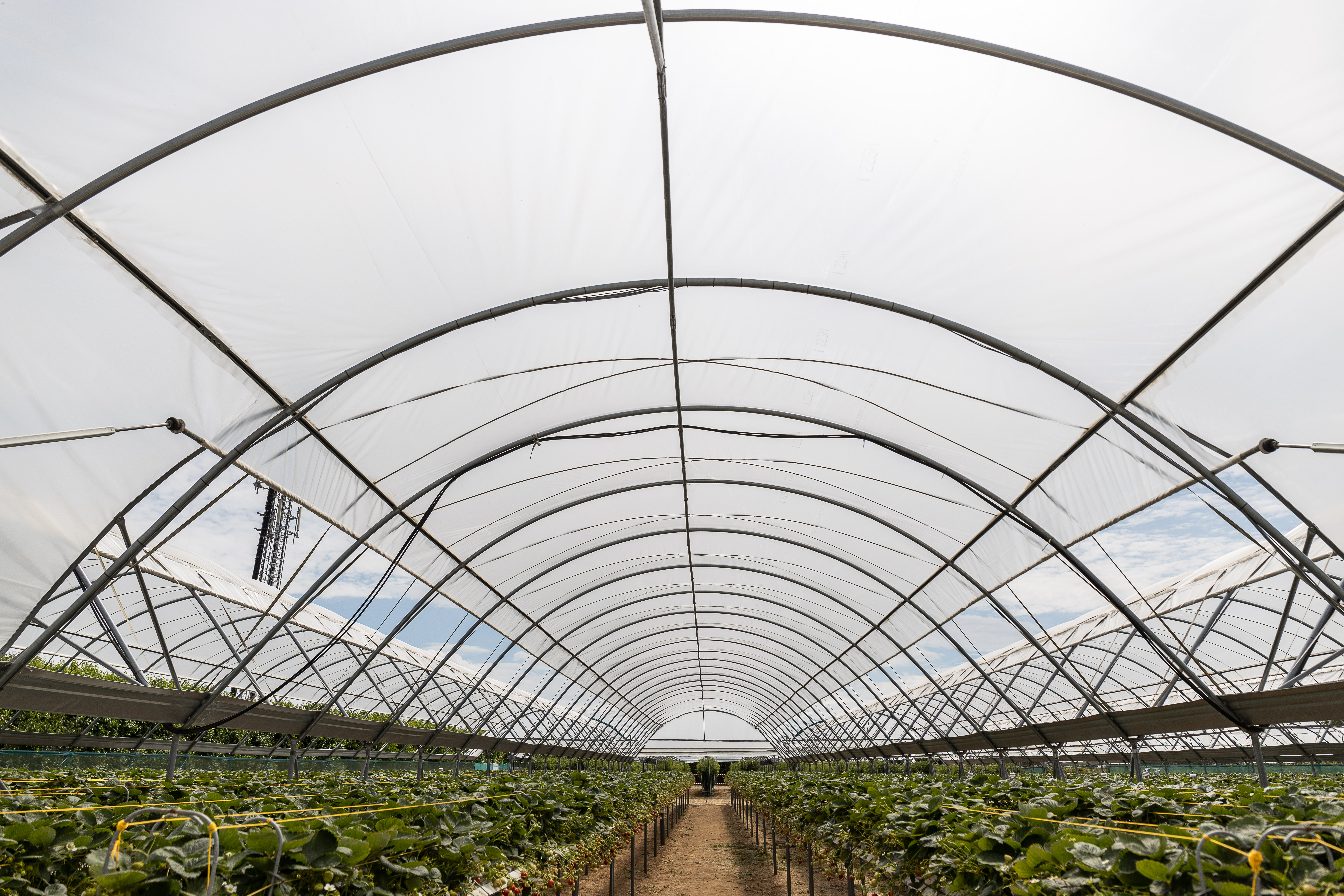 Yields differed between rows in a 6 row tunnel in the advanced area
Yields differed between rows in a 6 row tunnel in the advanced area
Row 1 on the Eastern side was also found to produce higher yields than Row 6 on the West, due, we think, to higher PAR in the morning when photosynthetic efficiency was at its highest. In an attempt to increase yields in Row 6 to match those in Row 1, additional LED lighting was installed in 2024 and applied every morning between 5 and 9 am during cropping. The effects of this treatment on cropping potential will be quantified in future work.
In the final three seasons the everbearer strawberry Malling Ace was used for demonstration at the Centre. In contrast to Malling Champion which was planted at a density of eight plants per metre in a staggered layout in the coir bag, the density of Malling Ace was reduced to six plants per metre, planted in a single line.
Commercial grower experience of planting Malling Ace at this lower density had unexpectedly resulted in higher yields per plant. Lower density planting also improves air movement around the plant, reducing humidity, and leading to improved control of powdery mildew, to which Malling Ace is sensitive. In 2023, another low light year, the plants produced an average of 1 kg per plant, and despite some early symptoms of powdery mildew being identified during weekly crop monitoring, a spray programme relying on products with both preventive and curative properties, ensured that little fruit was lost to the disease.
Number of drippers per bag
In work with Malling Ace planted at the lower density of six plants per metre in a line, bags with seven drippers produced higher yields (15g more Class 1 fruit per plant) than those with five drippers, but seven drippers used 3.2 litres more water per plant (10.5% increase). However, these results were not statistically significant so should be interpreted with caution.
Ultra violet-blocking film
Work investigated the effects of a UV-blocking film (originally developed as a non-chemical way of reducing pest numbers), on leaf physiology, Class 1 yields and berry quality.
When compared to Malling Champion plants cropping under a clear film, Class 1 yields were reduced by 15% under the UV-blocking film; this was due to a reduction in fruit number as individual berry fresh weight was increased slightly, presumably due to the slightly cooler (1°C) air temperatures under the UV-blocking film.
The loss of yield was associated with a reduction in the cumulated photosynthetically active radiation (PAR) reaching the canopy. Leaf physiology was also changed, with stomatal conductance and photosynthesis being lowered, and while the former response reduced plant transpirational water loss, the latter resulted in a 0.5% fall in the average berry soluble solids content (% Brix) over the season.
Choice of bag colour in strawberry
Studies took place during the lifetime of the Centre to compare strawberry bag colour. Class 1 yields were found to be 5% higher in white Cocogreen bags compared with black Cocogreen bags.
Powdery mildew risk prediction model
The Centre was also used to demonstrate how the use of the powdery mildew risk prediction model, developed originally by Niab plant pathologists at East Malling, could lead to a significant reduction in overall fungicide use on an everbearer strawberry variety.
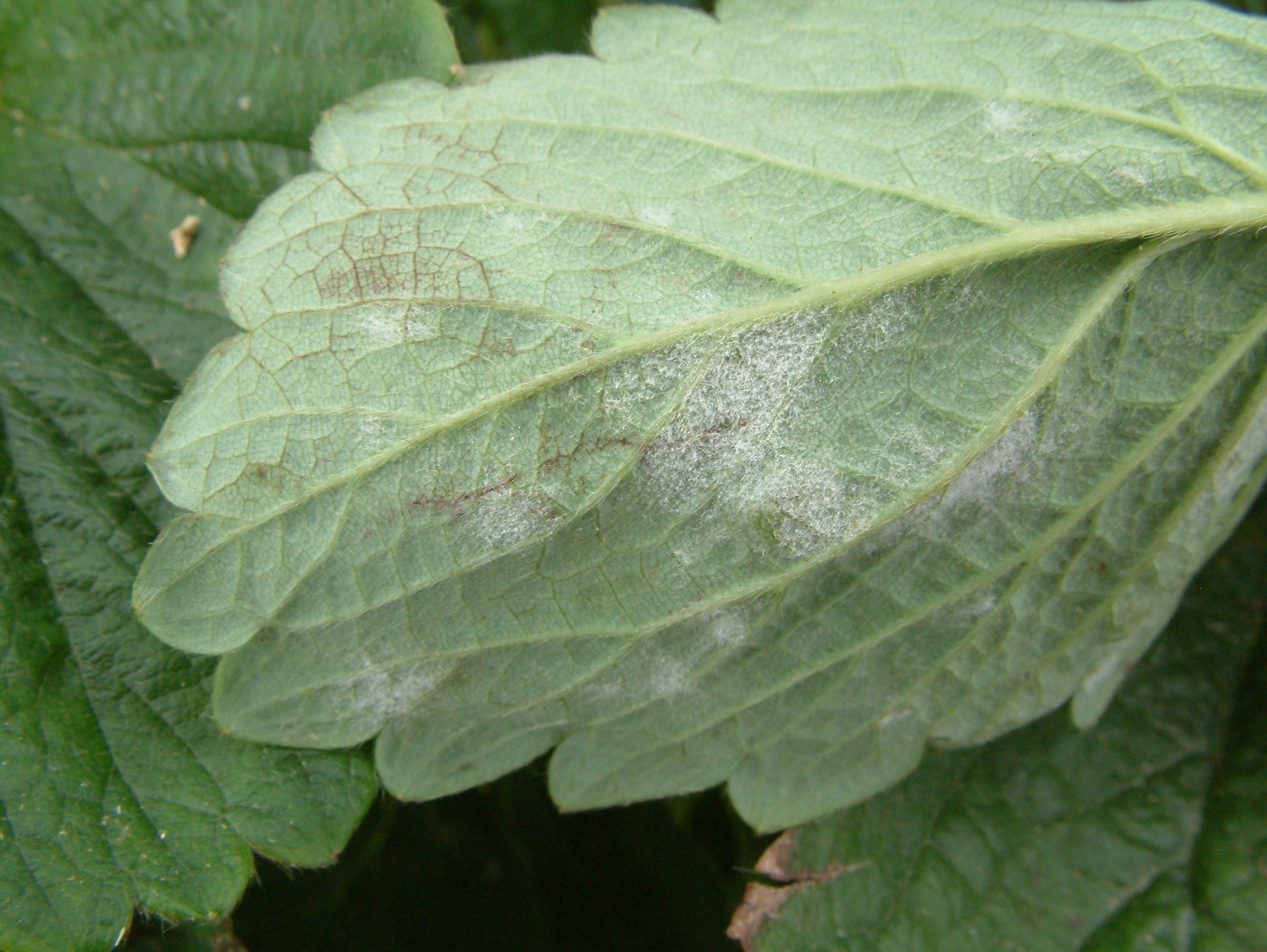 Strawberry powdery mildew
Strawberry powdery mildew
Nitrogen demand in raspberry
In an Innovate UK funded project carried out at The WET Centre, Niab adapted a mathematical model to predict the plant’s nitrogen demand based on growth stage. Inputs are adjusted to account for the effects of environmental variables such as temperature on nitrogen demand and partitioning. The model gave rise to a 76% reduction in nitrogen use compared to a commercial nitrogen fertiliser regime and a 37% reduction in water use, without affecting marketable yields or berry quality. In addition, leaf and cane growth were reduced leading to lower harvest and cane management costs.





